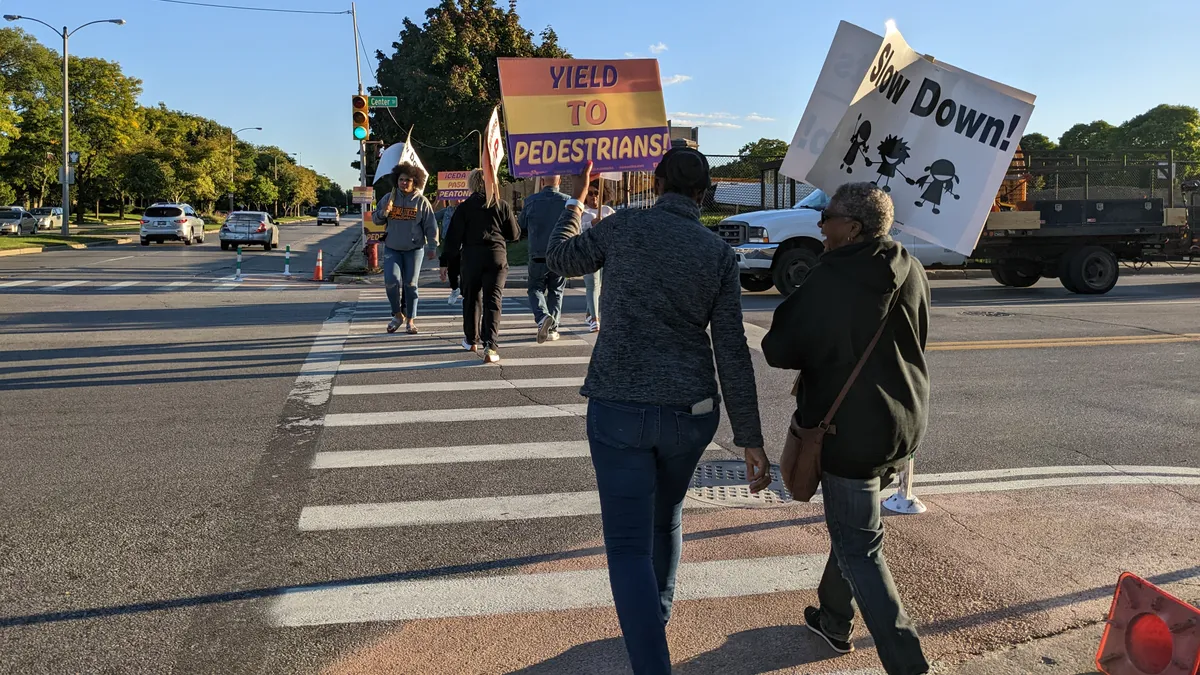Dive Brief:
- The top 20 deadliest U.S. metro areas for pedestrians saw increases in their average five-year fatality rates when comparing 2013 to 2017 with the 2018 to 2022 period, according to a report issued today by the nonprofit Smart Growth America.
- In 2022, the most recent year with complete federal data, 7,522 pedestrians were killed, a 40-year high and a 57% jump from 2013.
- The report named Memphis, Tennessee, worst among cities followed by Albuquerque, New Mexico; Tucson, Arizona, and Bakersfield, California. Florida’s Deltona-Daytona Beach-Ormond Beach metropolitan area and Baton Rouge, Louisiana, tied for fifth worst in average pedestrian fatality rates over the 2018 to 2022 period.
Dive Insight:
SGA experts speaking at a May 29 media briefing mainly blamed poor roadway design and ambivalence among elected officials for the increasing death rates. According to the report, “Our nation’s streets are dangerous by design, designed primarily to move cars quickly at the expense of keeping everyone safe.”
Roadway design is seen “almost exclusively through the lens” of the driver, said Beth Osborne, vice president of transportation and thriving communities at SGA.
Sun Belt cities ranked worst in the SGA report, largely due to having been built up in the era of the interstate highway, Osborne explained. “In many places of the South, you have a culture that built roads designed to get people through neighborhoods and through communities and built to be faster,” said Calvin Gladney, SGA president and CEO.
The toll on pedestrians is measured not only in deaths but also injuries. The SGA report found that more than 67,000 pedestrians were injured by traffic crashes in 2022, an 11% increase over the previous year. However, injury data is limited by the information reported by states to the U.S. Department of Transportation based on police reports from the scene of a crash, the report says.
Death and injury data does not include people using assisted mobility devices, such as wheelchairs or walkers, the report notes. The DOT groups these users along with those using skateboards and similar devices, “making it challenging to isolate the impact on people with disabilities,” the report states.
While cars have gotten safer for those inside vehicles, the danger to those outside of vehicles has grown. In 1994, 79% of traffic deaths were drivers and passengers in motor vehicles, while pedestrians represented 21% of victims. But by 2022, vulnerable road users accounted for 36% of fatalities, while 64% were vehicle occupants.
“We built an automobile-centric culture in this country,” Gladney said. “And we, for whatever reason, believe that it's just a cost of doing business that people walk and get killed every day.” The report defines people outside of vehicles as all pedestrians, motorcyclists, bicyclists and other non-occupants.
Gladney criticized decision-makers’ lack of action on pedestrian deaths. “There's a culture right now that just says there’s some acceptable number of people being hurt,” he said, adding that “we really need to figure out how to raise the ire of everyone to say that enough is enough.”
Osborne noted yearslong efforts to improve pedestrian safety but said that “it's just unfortunately a drop in the bucket compared to the hundreds of billions of dollars being spent to do the reverse.”
The SGA report does not make any recommendations but states that programs like Safe Streets for All “may provide one path of promise for the future.”












